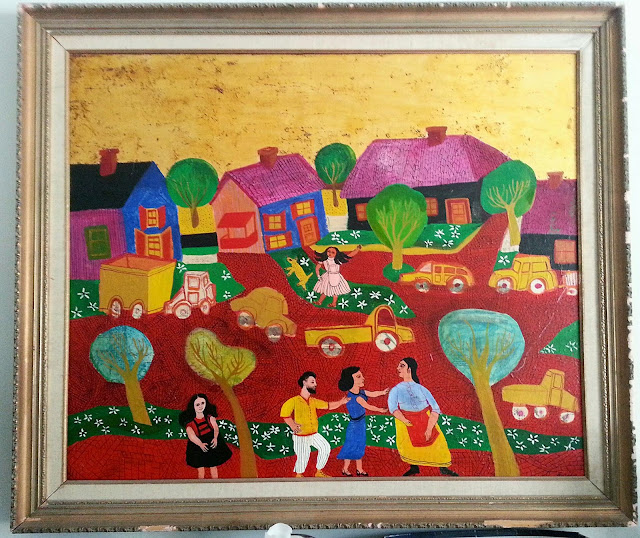
Fifteen years ago I wrote a monologue about the artist Baila Feldman, my mother, in a feminist literary magazine called 13th Moon, which has been published by the poet Judith Emlyn Johnson - a woman who was my mother-in-law. The story was on the cover, with a beautiful painting by Baila that I actually don't remember from real life. The issue it appeared it was this one:
13th Moon - A Feminist Literary Magazine
Volume XVII - Numbers 1 & 2 - 2002
http://www.13thmoon.net/html/13mmag.html
The text is as follows:
The issue's cover, Girl by the Mirror, 1968, and the folio of art work in the following pages are the work of Baila Feldman (April 12th 1932-August 20th, 1972)
Baila Feldman was born and grew up in Berwick in the Susquehanna River valley of northeast Pennsylvania. After initially attending Goucher College, she transferred to Barnard College, graduating in the class of 1952. In 1953 she married Robert Feldman, and in 1958 moved to San Francisco, where she gave birth to her daughter Rhea. In 1962, Feldman moved to the Berkeley hills, where she gave birth in 1964 to her son Joshua.
While living the life typical of a suburban housewife with a small child, Feldman received her MFA in art from the University of California at Berkeley. She was passionate about her art, throwing herself into it with deep convication; the awards and exhibitions soon followed. Her early styles were abstract and intellectually rigorous. Many of her mid-60s canvasses feature black line drawings of cultural icons juxtaposed on a stark white background.
Soon, however, she began to experiment with color and representation, painting impressionistically over African wood block print collages. Participating in the 1960s early feminist reconsiderations of subject matter, figuration, and multiple ethnicities, her work soon became characterized by broad sweeping lines, saturated colors, and images of animals, families, floral still lives, and nudes. Finally, she abandoned the woodblock collage backgrounds in favor of icon-style gold leaf and painted fields, while discovering a playful lyrical line evocative outsider art and folk, primitive, and tribal styles. This was the approach that characterized her late Judaic, family, San Francisco bay area, and Mexican city scenes. Her many gallery shows and exhibitions received good press coverage, and her work was in demand in the late sixties, particularly the canvasses in folk and ethnic styles. A number of these canvasses were reproduced as holiday cards.
During the late 60s, like other women of the time, but in addition, probably as a breast cancer patient feeling pressure to pack in a great deal of experience and work into the short time remaining to her, Feldman participated in the counter-culture art and drug scenes. Her house, a swinging commune, was filled with groupies, acid guides, alternate health practitioners, and a number of live-in students. Always, however, art remained her first passion. Especially during daylight, she could be found in the glass-walled studio floor of her house, which looked out over eucalyptus trees and a view of the San Francisco bay.
 In the last years of her life, partially influenced by the increased 1960s emphasis on community and collaboration, and partly necessitated by her struggle against cancer, she began working with art students. The students did canvas prep and technical work, like gold leap sky backgrounds, while learning from Feldman how compositional elements could function within these fields. Typically, she worked on several canvasses at time, moving from one to another when she needed to freshen her eye. She loved to look at the work of other artists, and took inspiration from other ethnicities and cultures: Africa, ancient Egypt, Mexican, Judaic, American and Pennsylvania Dutch folk art. She continued painting until August 20th 1972, when she died of breast cancer.
In the last years of her life, partially influenced by the increased 1960s emphasis on community and collaboration, and partly necessitated by her struggle against cancer, she began working with art students. The students did canvas prep and technical work, like gold leap sky backgrounds, while learning from Feldman how compositional elements could function within these fields. Typically, she worked on several canvasses at time, moving from one to another when she needed to freshen her eye. She loved to look at the work of other artists, and took inspiration from other ethnicities and cultures: Africa, ancient Egypt, Mexican, Judaic, American and Pennsylvania Dutch folk art. She continued painting until August 20th 1972, when she died of breast cancer.--written by Joshua Feldman
















